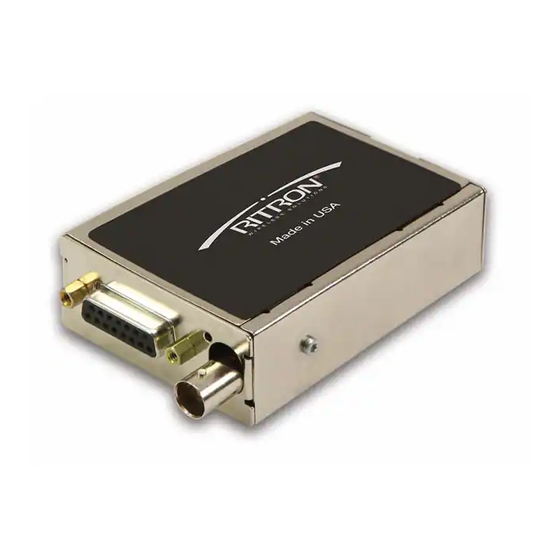
Summary of Contents for Ritron DTX- 60 Series
- Page 1 RITRON, INC. PRELIMINARY 07-12 RITRON MODELS DTX-X60 SERIES PROGRAMMABLE FM TRANSCEIVER MODULES OPERATING MANUAL PRELIMINARY!
-
Page 2: Table Of Contents
TABLE OF CONTENTS INTRODUCTION GENERAL MODEL IDENTIFICATION FCC REGULATIONS MODELS DTX-154 AND DTX-454 SPECIFICATIONS GENERAL TRANSMITTER RECEIVER DTX-154/454 INPUT/OUTPUT CONNECTOR ACCESSORIES OPERATION CHANNEL SELECTION POWER SUPPLY VOLTAGE DUTY CYCLE/KEY-DOWN LIMITATIONS OPERATING MODES RNET COMPATIBILITY MODE... -
Page 3: Introduction
INTRODUCTION GENERAL The RITRON DTX Plus modules are programmable 2-way radios, which operate either in the VHF or UHF professional FM communications bands as well as a number of other bands in the 220 MHz and 350 MHz region. Each of eight channels can be programmed to contain a unique set of operating frequencies. The DTX Plus module is made up of two PC boards, an RF board and a control/loader board. -
Page 4: Fcc Regulations
E designates the maximum power level: 3=3 watts 6=6 watts 9=10 watts F designates whether the control/loader board has a regulator and if so, at what current level: D=no regulator; the unit must operate from external, regulated +7.5 VDC and is limited to either 3 or 6 watts max. - Page 5 This 2-way radio uses electromagnetic energy in the radio frequency (RF) spectrum to provide communications between two or more users over a distance. It uses radio frequency (RF) energy or radio waves to send and receive calls. RF energy is one form of electromagnetic energy. Other forms include, but are not limited to, electric power, sunlight and x-rays.
- Page 6 Use of other accessories may not ensure compliance with the FCC’s RF exposure guidelines, and may violate FCC regulations. • For a list of Ritron approved accessories see this user manual, or visit the following website which lists approved accessories: www.ritron,com...
-
Page 7: General
SPECIFICATIONS GENERAL FCC Identifier DTX-160-0 AIERIT28-160 (Pending) DTX-460-0 AIERIT28-460 (Pending) FCC Rule Parts Industry Canada Rule Parts RSS-119 Frequency Range DTX-160-G 136-162 MHz* DTX-160-0 148-174 MHz* DTX-260-0 220-245 MHz* DTX-360-G 340-360 MHz* DTX-360-0 360-380 MHz* DTX-360-M 380-400 MHz* DTX-460-G 400-430 MHz* DTX-460-A 420-440 MHz * DTX-460-B... -
Page 8: Transmitter
RF Input/Output Connector BNC standard Power/Data Interface 15 pin subminiature D type Operating Temperature -30 to +60 C 3.6” x 2.3” x 1.0” including connectors Maximum Dimensions (L x W x H) Weight 6 oz. * Not Available Yet TRANSMITTER Operating Bandwidth Up to the span of the sub-band RF Output Power (internally adjustable) -
Page 9: Receiver
RECEIVER Operating Bandwidth Up to span of the sub-band Sensitivity (12 dB SINAD @ 1 kHz w de-emphasis) 0.25 uV (-119.0 dBm) RF Input Impedance 50 ohms nominal Adjacent Channel Selectivity +/-6.25 kHz w very narrow IF 45 dB min. +/- 12.5 kHz w narrow IF 60 dB min. -
Page 10: Dtx-154/454 Input/Output Connector
DTX INPUT/OUTPUT CONNECTOR Connector Pinout Pin Number Name Description Comments Channel Select low bit Channel Select mid bit Channel Select high bit MIC IN Microphone Input Input for microphone type signals to be transmitted. Signals at this input are pre-emphasized, limited, and filtered. - Page 11 Note: Due to the internal pull-up resistors, the unit defaults to channel 8 if the channel pins are left open (unconnected). Channel 8 would be the nominal channel when the Ritron programmer is connected. MIC IN-Microphone input. This input accepts microphone-type input signals for transmit.
- Page 12 Therefore, it is not recommended that this output drive loads with less than 1000 ohms unless the resultant voltage drop is accounted for. PGN IN/OUT-Connect via RITRON DTXP-PCPK PC Programming Kit to computer for programming the unit. CTS-Clear-To-Send output from the unit which indicates that the unit is transmitting a carrier at the correct frequency and power level and is ready to accept an input signal to be transmitted.
-
Page 13: Accessories
ACCESSORIES Note: Programming kits are for use by authorized service/maintenance personnel only. The Programming Kit for DTX-154/454 radios (via compatible computer) is model DTXP-PCKT. It includes: 1) Programming software diskettes, 3.5” (qty 2). 2) 1 25 pin PC to 6 pin modular adapter cable with built-in interface circuitry. 3) 1 modular adapter to DB-15 connector cable with power cable. -
Page 14: Operation
Do NOT apply voltages outside the range of 0 to +5 volts to these pins. Note: When the Ritron programming cable is connected, these pins are not connected and thus, assume a logic high state. Therefore, the radio will be on channel 8 when the Ritron programming cable is connected. - Page 15 CURRENT DRAIN VS SUPPLY VOLTAGE The current drain of the module is a function of the supply voltage, the RF output in transmit and the regulator option. The internal 7.5-volt regulator is a switching type such that the current drain actually decreases with an increase in supply voltage.
-
Page 16: Duty Cycle/Key-Down Limitations
Ritron offers an option where the case screws at the rear of the module are longer allowing heat sinks to be attached. Contact Ritron for additional information on this option and special instructions on attaching heat sinks without compromising the... -
Page 17: Operating Modes
AC coupling removes this issue. The output stage is AC coupled, but can be modified for DC coupling. This requires replacing a coupling capacitor with a zero-ohm resistor. Contact Ritron for details on this modification. The AUDIO OUT is always de-emphasized, but its gain can be programmed. This output can drive 8-ohm speaker-type loads. -
Page 18: Rnet Compatibility Mode
AUX IN gain setting. The end user/system integrator would then bear the responsibility of obtaining certification or operating in a frequency band where certification is not required. Contact RITRON for details. Note: Most modems will connect directly to the DTX without requiring any special modifications or programming.




